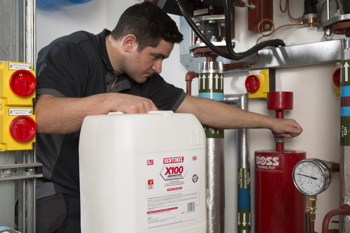Time to raise the bar in water treatment

Water-treatment regulations and product standards are almost entirely absent in the non-domestic market. Chris Shelton of Sentinel Commercial explains the financial and operational benefits of proactively embracing a best practice approach to water treatment — and how it can be easily and cost-effectively implemented.
Commercial heating and hot-water systems are massive financial investments, often incurring an initial outlay of tens or hundreds of thousands of pounds — followed by significant ongoing energy and operational costs (up to 60% of an organisation’s total energy use, according to the Carbon Trust). Money aside, heating and hot water are also crucial to business continuity; sudden failure of a system could result in disruption and inconvenience, expensive temporary boiler hire, possibly even closure of a facility and relocation of occupants during remedial works.
In short, heating and hot-water systems are important assets in commercial buildings, and should be treated as such — that is, they should be installed, commissioned, maintained and serviced correctly, ideally to manufacturers’ specifications. Sadly, however, this is more the exception than the rule in the commercial heating sector, as one vital ingredient in system care, water treatment, is often insufficient or entirely absent.
Inadequate water treatment will give rise to corrosion and limescale — the latter in systems located in areas served by hard water, which is around two thirds of mainland England. Both problems have significantly negative impacts on heating and hot water systems.
For example, corrosion generates a black iron-oxide sludge that accumulates in pipes, pumps, seals, heat exchangers, diverter valves and heat sources such as radiators. In addition to blockages, sludge leads to a reduction in energy efficiency, cold spots on radiators, and can lower system effectiveness by typically 15% (Gastec CRE). Small flakes of corroded metals, particularly iron and mild steel, are abrasive and tend to erode components in a heating system, such as pump shaft seals.
In ‘once-through’ water heaters, limescale is a significant problem; it is problematic in closed heating systems, but to a far less extent.
 |
| Best-practice water treatment will help to ensure optimum system performance, efficiency and longevity, and prevent extremely costly and highly disruptive corrosion and limescale related problems |
Calcium salts exhibit inverse solubility as temperatures rise, and will begin to precipitate at around 35 to 40°C. As a result, limescale accumulates rapidly, particularly on heat transfer surfaces such as calorifiers and heat exchangers. Limescale has a number of detrimental effects, from reducing efficiency (British Water estimates that just 1.6 mm of limescale accumulation can increase a heating system’s energy requirement by up to 12%) to restricted water flow, and wear and tear on components.
Ultimately, both corrosion and limescale are likely to lead to downtime, replacement costs, higher energy bills, and unplanned maintenance and repairs — sometimes within months of commissioning.
These problems could be prevented with best-practice water treatment, which is inexpensive and relatively easy to achieve, yet poor water-treatment practices are rife in the commercial sector. The reasons why are complex and numerous. However the lack of strict Building Regulations in the commercial sector (unlike the Domestic Building Services Compliance Guide to Part L, which offers very good water-treatment regulations for protecting domestic heating systems), in addition to an absence of formal British Standards to set worthy quality benchmarks for water-treatment products, do not help.
Consequently, it is up to specifiers, contractors and installers to proactively embrace a best-practice approach to water treatment, which when correctly administered using high-quality chemicals, can deliver lifetime protection from corrosion and limescale — surely something which will help advocates to stand out in a crowded and competitive marketplace.
The administering of water treatment is difficult to summarise, and, indeed, it would be unwise to do so as commercial systems can vary so greatly in type, size, complexity, age and history. However, most systems will greatly benefit from a best-practice approach that is extolled by leading industry bodies and boiler and system component manufacturers alike; it includes system cleaning, protection and maintenance.
Cleaning is a process that removes debris from new and existing systems, and prepares the system for protection. The cleaning chemical used should be appropriate for the system type and age, as well as the type and extent of the ‘problem’. For example, a new system may require a cleaning agent that can remove greases, flux and installation debris, while an older, seriously fouled closed system would need one that’s able to shift heavy oxide sludge.
 |
| Small flakes of corroded metals tend to erode components in a heating system. |
Protection is delivered via a chemical inhibitor for closed heating systems (with an optional system filter for extra insurance), and a limescale prevention device for once-through water heaters. A driven electrolytic device (a methodology recommended in Part L), which can be installed on a rising main for whole-system protection, is a good option with regard to whole-life costs since these require minimal maintenance and do not waste water.
Finally, a programme of planned preventive maintenance is imperative. For closed heating systems, this would involve checking the health of circulating water and inhibitor levels on a regular basis (topping up the latter if necessary), while electrolytic limescale prevention devices should be serviced according to the manufacturer’s instructions.
To steer around potentially poor-quality products, it is wise to specify those that come with boiler-manufacturer endorsement (a recommendation that can be found in boiler installation and servicing manuals). These brands should also be able to evidence strong signs of reputability, such as a history of research and development, training and innovation, as well as excellence service through on-site support.
Best-practice water treatment does require a little extra work, effort and expense compared to less ideal options. However, it is guaranteed to pay dividends by helping to ensure optimum system performance, efficiency and longevity, and preventing a plethora of unnecessary, extremely costly, and highly disruptive corrosion and limescale-related problems.
Chris Shelton is sales director at Sentinel Commercial.







